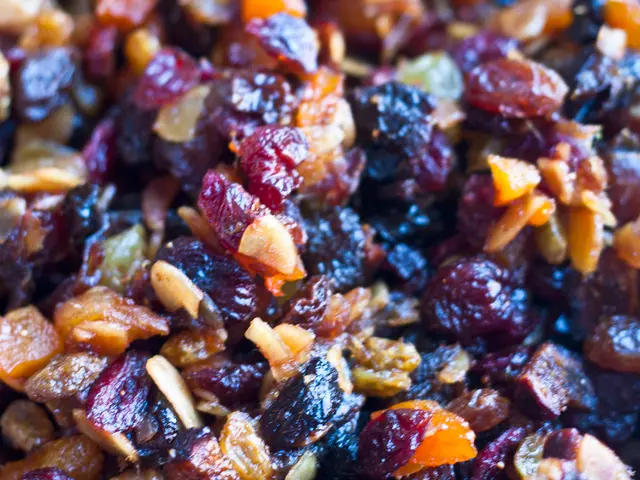Natural Remedy for Gallstone Treatment: Chanca Piedra
In the realm of traditional medicine, chanca piedra (Phyllanthus niruri) has long been hailed as a "stone breaker" for kidney and gallbladder stones. This perennial shrub, native to tropical and subtropical regions, has been used for centuries in various cultures to support stone dissolution.
While the scientific evidence for chanca piedra's effectiveness in treating gallstones is limited, some preliminary findings are promising. For instance, research from 2017 suggests that chanca piedra exhibits anti-HBV activity, slowing the replication of the hepatitis B virus[1]. This could potentially extend to gallstones, although direct scientific evidence remains insufficient.
One of the key points supporting chanca piedra's potential effectiveness is its smooth muscle relaxant effect. Some studies suggest that the herb may help relax the bile ducts and ureter, potentially facilitating the passage of stones[2]. Furthermore, chanca piedra has a long history in traditional medicine, with anecdotal and historical reports claiming it supports stone dissolution[3][5].
However, robust clinical trials specifically evaluating chanca piedra’s effect on gallstones are scarce or lacking. Most existing studies focus on kidney stones, and direct scientific evidence for gallbladder stone treatment remains insufficient[4]. More high-quality randomized controlled trials are needed to establish both efficacy and safety for gallstone treatment.
| Aspect | Status | |-------------------------------|---------------------------------------------------------| | Traditional and anecdotal use | Well-documented over centuries for stones[3][5] | | Mechanistic studies | Suggest smooth muscle relaxation aiding stone passage[4]| | Clinical trial evidence | Limited or indirect; mostly pilot or small studies on kidney stones, not gallstones | | Large-scale controlled trials | Not yet available; needed for confirmation |
Animal studies indicate that chanca piedra may improve fasting blood sugar levels, potentially beneficial for diabetes management. Additionally, it may help prevent acidic kidney stones due to its alkalizing properties[6]. However, there is no scientific evidence suggesting that chanca piedra treats gallstones directly.
It's essential to note that while chanca piedra may support gallbladder health indirectly, users should consult healthcare providers before use, especially because gallstones sometimes require medical or surgical intervention. Side effects of chanca piedra may include abdominal pain, painful urination, blood in urine, nausea, and a significant rise in urine potassium levels[7].
Before taking chanca piedra for a specific ailment, particularly if a person has prescription medications, they should speak with a healthcare professional. Chanca piedra may eliminate or prevent Helicobacter pylori in test-tube studies, a common cause of digestive disorders[8]. Some claims suggest that chanca piedra may help with gout by correcting the overproduction of uric acid[9].
Chanca piedra is commercially available as supplements containing elements from the entire plant, including stems, leaves, and flowers, in forms such as tablets, capsules, liquid extracts, and teas. The FDA does not regulate supplements in the same way as pharmaceutical drugs, and manufacturers do not have to demonstrate the safety and effectiveness of a product before they produce and sell it[10].
In traditional medicine, chanca piedra is used as an herbal remedy for various ailments, including inflammation, fever, malaria, lithiasis, gonorrhea, and hepatitis[11]. While the evidence for its effectiveness in treating gallstones is limited, chanca piedra remains a topic of ongoing research and interest in the medical community.
References:
- Chanca piedra: A potential anti-hepatitis B virus agent
- Phyllanthus niruri: A review of its traditional uses, phytochemistry, pharmacology, and therapeutic potential
- Traditional uses and pharmacological potential of Phyllanthus niruri: A review
- Phyllanthus niruri: A review of its pharmacological activities
- Phyllanthus niruri L.: A review of its traditional uses, pharmacological activities and phytochemistry
- Phyllanthus niruri L.: A review of its traditional uses, pharmacological activities and phytochemistry
- Phyllanthus niruri: A review of its pharmacological activities
- Antimicrobial and cytotoxic activities of Phyllanthus niruri Linn. (Euphorbiaceae) extracts against Helicobacter pylori
- Phyllanthus niruri: A review of its pharmacological activities
- FDA Regulation of Dietary Supplements
- Traditional uses and pharmacological potential of Phyllanthus niruri: A review
- Chanca piedra, a traditionally known "stone breaker," has been used in various cultures for centuries to support the dissolution of kidney and gallbladder stones, though scientific evidence for its effectiveness in treating gallstones is limited.
- Some studies suggest that chanca piedra may help relax the bile ducts and ureter, potentially facilitating the passage of stones, due to its smooth muscle relaxant effect.
- Animal studies indicate that chanca piedra may improve fasting blood sugar levels, which could be beneficial for diabetes management, and may help prevent acidic kidney stones due to its alkalizing properties.
- However, robust clinical trials specifically evaluating chanca piedra’s effect on gallstones are scarce or lacking, and more high-quality randomized controlled trials are needed to establish both its efficacy and safety for gallstone treatment.
- Chanca piedra, commercially available as supplements, may also have applications in managing chronic diseases and health-and-wellness therapies, such as aiding in digestive disorders like Helicobacter pylori infections or gout, though further scientific investigation is required for these claims.




